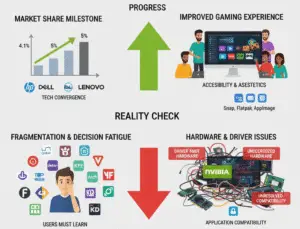
Sustainable Technology in 2025: A Greener Future is Here

By 2025, technology won’t just be smart—it will be sustainable. Imagine solar-powered smartphones, carbon-neutral data centers, and AI that helps reduce waste. The future of tech is all about saving the planet while improving our lives.
In this article, we’ll explore:



What is Sustainable Technology? A Simple Guide with Real-Life Examples
Sustainable technology, often called “green tech,” includes innovations designed to protect the environment while meeting human needs. These technologies aim to:




The goal is simple: Create a healthier planet without sacrificing modern comforts.
How Does Sustainable Technology Work? (With Examples)
1. Renewable Energy Tech – Power from Nature
Instead of burning coal or oil (which pollutes the air), sustainable tech uses natural energy sources like:
Solar panels – Convert sunlight into electricity for homes and businesses.
Wind turbines – Use wind to generate power without emissions.
Hydropower – Uses flowing water (like dams) to produce energy.
Example: A house running on solar panels instead of coal-powered electricity reduces CO₂ emissions.
2. Energy-Efficient Devices – Doing More with Less
Some technologies help us use less energy without sacrificing performance:
LED bulbs – Last longer and consume 75% less energy than old incandescent bulbs.
Smart thermostats – Automatically adjust heating/cooling to save power.
Electric vehicles (EVs) – Replace gas-guzzling cars with cleaner battery power.
Example: A Tesla electric car runs on batteries (charged by renewable energy) instead of gasoline, cutting down air pollution.
3. Waste Reduction & Recycling Tech – Turning Trash into Treasure
Instead of throwing things away, sustainable tech finds new uses for waste:
Compostable packaging – Made from plants (like cornstarch) instead of plastic.
Recycled materials – Old plastic bottles turned into new clothing or furniture.
Food waste apps – Like Too Good To Go, which sells leftover food at a discount to prevent waste.
Example: Adidas shoes made from ocean plastic help clean up pollution while making useful products.
4. Water-Saving Innovations – Using Every Drop Wisely
Freshwater is limited, so green tech helps conserve it:
Low-flow showerheads – Reduce water use without sacrificing pressure.
Smart irrigation systems – Water crops only when needed, avoiding waste.
Greywater recycling – Reuses water from sinks/showers for gardening.
Example: A smart sprinkler system detects rain and skips watering, saving thousands of gallons yearly.
Why Does Sustainable Technology Matter?
Fights climate change by reducing greenhouse gases.
Saves money in the long run (e.g., lower energy bills with solar panels).
Reduces pollution, leading to cleaner air and water.
Creates jobs in green industries like solar installation and EV manufacturing.
The Future of Green Tech
From lab-grown meat (reducing livestock emissions) to carbon capture (removing CO₂ from the air), sustainable tech keeps evolving. The more we adopt these solutions, the closer we get to a cleaner, healthier planet.
5 Biggest Sustainable Tech Trends Shaping 2025
As the world moves toward a greener future, technology is leading the charge with innovations that reduce waste, save energy, and protect the planet. Here are the five biggest sustainable tech trends in 2025—explained in simple terms with real-world examples.
1. Renewable Energy Breakthroughs
Fossil fuels are on their way out, thanks to smarter, cleaner energy solutions.
Key Innovations:



Real-World Example:
Tesla’s Solar Roof turns your entire house into a mini power plant, blending solar tiles seamlessly with traditional roofing.
2. Energy-Efficient AI & Data Centers
Tech companies are slashing energy waste with smarter systems.
Key Innovations:



Real-World Example:
Google’s DeepMind AI predicts cooling needs in data centers, reducing energy costs by 40%.
3. Electric & Self-Sustaining Transport
The future of travel is electric, solar-powered, and waste-free.
Key Innovations:



Real-World Example:
Tesla’s Cyber truck uses ultra-efficient batteries made from recycled materials, reducing mining waste.
4. Circular Economy & Zero-Waste Tech
Waste is being redesigned out of the system entirely.
Key Innovations:



Real-World Example:
Adidas’ Futurecraft.Loop sneakers are designed to be 100% recyclable—old shoes become new ones.
5. Smart Cities & Green Buildings
Cities are getting smarter—and more sustainable.
Key Innovations:



Real-World Example:
Singapore’s “Green Buildings” use AI to reduce energy consumption by 30%, setting a global standard.
Final Thoughts
From solar-powered cars to waste-free smartphones, these sustainable tech trends prove that innovation can go hand-in-hand with environmental responsibility. Which trend excites you the most?
Why Does Sustainable Tech Matter?




Challenges in 2025
While sustainable tech is growing, obstacles remain:
High Initial Costs – Solar panels and EVs are still expensive for some.
E-Waste Recycling – Only 17% of global e-waste is properly recycled.
Policy & Adoption – Governments and companies must invest more.
How You Can Be Part of the Green Tech Revolution




The Future: What’s Next After 2025?
Space-Based Solar Power – Collecting solar energy from orbit.
Algae Biofuel – Renewable fuel made from fast-growing algae.
Carbon Capture Tech – Machines that suck CO2 from the air.
Final Thoughts
Sustainable technology in 2025 isn’t just a trend—it’s a necessity. From solar-powered homes to waste-free manufacturing, green tech is shaping a cleaner, smarter future.




